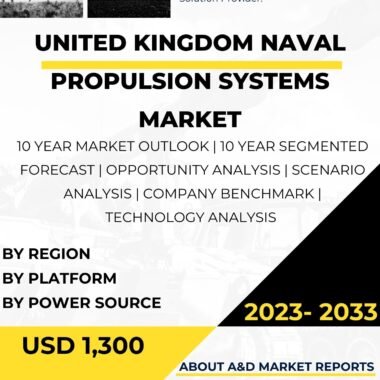Description
The naval propulsion systems market in Japan holds significant importance as the nation focuses on enhancing its maritime capabilities and strengthening its naval forces in response to regional security challenges. Naval propulsion systems are crucial for powering various naval platforms, including destroyers, frigates, submarines, and patrol vessels, enabling Japan to maintain a robust maritime presence and protect its sea lanes, territorial waters, and exclusive economic zones (EEZs). As Japan seeks to bolster its naval deterrence and maintain maritime superiority, the demand for advanced naval propulsion systems has grown, leading to increased research, development, and investment in this field.
Naval propulsion systems in Japan encompass a wide range of technologies, including diesel engines, gas turbines, electric propulsion systems, and nuclear propulsion. Each of these propulsion technologies offers distinct advantages and is tailored to different types of naval vessels and operational requirements.
One of the primary applications of naval propulsion systems in Japan is in surface combatants. Gas turbine engines are commonly used in Japan’s destroyers and frigates, providing high-speed propulsion and enabling rapid response capabilities. These surface combatants are equipped with advanced propulsion systems, allowing them to conduct a wide range of naval operations, including anti-surface warfare, anti-air warfare, and anti-submarine warfare.
Moreover, naval propulsion systems are also crucial for submarines. Diesel-electric propulsion systems are commonly used in Japan’s conventional submarines, providing quiet and stealthy underwater operations. These submarines play a critical role in Japan’s maritime defense strategy, enabling the nation to conduct covert surveillance, intelligence gathering, and anti-submarine warfare operations.
Additionally, naval propulsion systems contribute to Japan’s maritime surveillance and patrol vessels. These vessels utilize various propulsion technologies, including diesel engines and electric propulsion systems, to conduct maritime security operations, enforce territorial waters, and safeguard Japan’s maritime interests.
As Japan emphasizes indigenous defense capabilities, the domestic production and development of naval propulsion systems have seen substantial growth. Collaborations between the government, defense industry, and research institutions have fostered innovation, leading to the creation of advanced naval propulsion technologies tailored to Japan’s specific defense requirements.
Japan’s alliance with the United States has also played a significant role in the development of its naval propulsion capabilities. Through this partnership, Japan has access to advanced technologies and expertise, contributing to the modernization of its naval forces and enhancing interoperability with allied navies.
The naval propulsion systems market in Japan also benefits from advancements in materials science, power generation technology, and propulsion system integration. Manufacturers have leveraged these developments to create naval propulsion systems with improved fuel efficiency, reduced noise signatures, and increased power output.
However, the naval propulsion systems market in Japan also faces challenges related to cost, technological advancements, and the transition to greener propulsion options. Developing and maintaining advanced naval propulsion systems can be costly, requiring significant investment in research, development, production, and training.
Continued technological advancements, such as the integration of hybrid propulsion systems and electric propulsion, require Japan’s naval forces to stay at the forefront of naval propulsion technology and operational concepts.
Addressing environmental concerns is also crucial, as the global maritime community increasingly emphasizes the adoption of greener propulsion options to reduce emissions and enhance sustainability.
In conclusion, the naval propulsion systems market in Japan has witnessed significant growth and strategic importance, driven by the nation’s focus on enhancing its maritime capabilities and strengthening its naval forces in response to regional security challenges. Naval propulsion systems provide critical capabilities for surface combatants, submarines, and maritime patrol vessels, making them integral to Japan’s maritime defense strategy. The collaboration between the government, defense industry, and research institutions, as well as international partnerships with allied nations, fosters innovation and contributes to the growth of the domestic naval propulsion systems market. Addressing challenges related to cost, technological advancements, and the transition to greener propulsion options is crucial for further enhancing Japan’s naval propulsion capabilities and ensuring that the nation’s naval forces remain equipped with advanced and reliable propulsion systems to maintain maritime superiority and effectively respond to evolving security threats. With its strategic focus on enhancing indigenous defense capabilities, Japan remains committed to leveraging advanced naval propulsion technologies to enhance its maritime security and contribute to regional and global naval stability.




